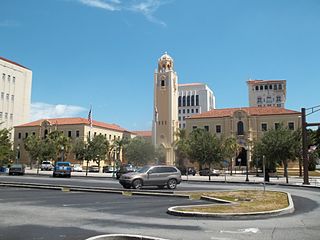
The Sarasota County Courthouse is a historic courthouse building located at 2000 Main Street in Sarasota, Florida. Designed by architect Dwight James Baum in the Mediterranean Revival style, it was built in 1926-1927 by Stevenson and Cameron, Inc. On March 22, 1984, it was added to the U.S. National Register of Historic Places.

The Hernando County Courthouse, built in 1913, is an historic courthouse building located in Brooksville, Florida, It was designed by Atlanta-based architect William Augustus Edwards who designed one other courthouse in Florida, two in Georgia and nine in South Carolina as well as academic buildings at 12 institutions in Florida, Georgia and South Carolina. He designed most of the original buildings on the campus of the University of Florida in Gainesville.
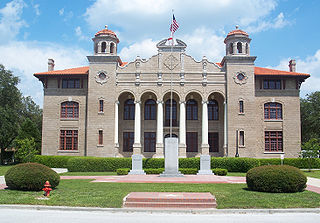
The Sumter County Courthouse, built in 1912-1914, is an historic courthouse building located in Bushnell, Florida. The total costs of construction for the courthouse were $56,000. It was designed by Atlanta-based architect William Augustus Edwards who designed one other courthouse in Florida, two in Georgia and nine in South Carolina as well as academic buildings at 12 institutions in Florida, Georgia and South Carolina. He designed most of the original buildings on the campus of the University of Florida in Gainesville. In 1989, The Sumter County Courthouse was listed in A Guide to Florida's Historic Architecture, published by the University of Florida Press.
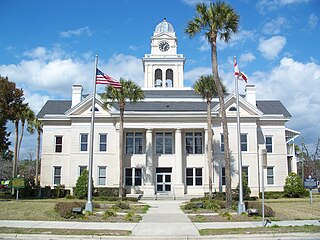
The Lafayette County Courthouse, built in 1908, is an historic courthouse building located in Mayo, Florida, It was designed by Atlanta-based architect Edward Columbus Hosford in the Classical Revival style, who designed other courthouses in Florida and other states. It was built of Indiana limestone by the Mutual Construction Company of Louisville, Kentucky. Because there was no railroad into Lafayette County, the limestone and other materials were shipped by rail to O'Brien in Suwannee, County and then transported by wagon to Mayo, crossing the Suwannee River via Grant's Ferry north of Troy Springs. It is Lafayette County's third courthouse, the first at New Troy having burned down New Year's Eve 1892 and the second wooden structure in Mayo having been moved across the street to make way for a fireproof building. In 1989, the Lafayette County Courthouse was listed in A Guide to Florida's Historic Architecture, published by the University of Florida Press.

The Madison County Courthouse, built in 1913, is a historic courthouse building located in Madison, Florida. It is Madison County's fourth courthouse and the third built in Madison. The first log building at San Pedro was abandoned along with the town. The second courthouse built in 1840 in Madison burned in 1876 and was replaced by an 1880 brick structure which burned in 1912. The present building is unusual among Florida courthouses of its vintage in never having been added onto or expanded. In 1989, the Madison County Courthouse was listed in A Guide to Florida's Historic Architecture, published by the University of Florida Press.

The Old Lafayette County Courthouse, built 1893-1894, is an historic former courthouse building located on State Road 51 at 136 Fletcher Avenue, North, corner of Bloxham Street in Mayo, Florida, It was Lafayette County's second courthouse, the first at New Troy having burned down New Year's Eve 1892. It was built on the courthouse square in Mayo but was moved across the street to make way for a fireproof building, the present Lafayette County Courthouse. A two-story verandah was added on 3 sides after it was moved. In 1989, the Old Lafayette County Courthouse was listed in A Guide to Florida's Historic Architecture, published by the University of Florida Press. Today it is an inn called the Chateau.

The Levy County Courthouse, built in 1937, is a historic redbrick Classical Revival style courthouse building located in Bronson, Florida. It was designed by architect Henry L. Taylor and built by O. R. Woodcock. It is Levy County's fourth purpose-built courthouse and the third one built in Bronson. Some material salvaged from the previous (1906) courthouse were used in its construction. An annex has been added to it.

The Washington County Courthouse was an historic brick courthouse building located in Chipley, Florida. It was built in 1932 in the Classical Revival style after Chipley won a 1927 referendum to move the county seat from Vernon

The Old Gulf County Courthouse is a historic redbrick courthouse building located at 222 North 2nd Street in Wewahitchka, Florida. It was built in 1927 in the Classical Revival style after Wewahitchka was designated the county seat of newly created Gulf County. In 1965 the county seat was moved to Port St. Joe and a new courthouse was built there. The old courthouse still functions as an auxiliary to the Port St. Joe courthouse.
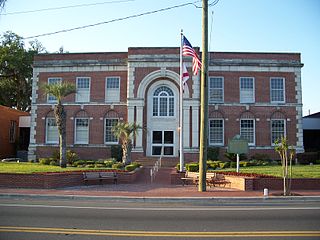
The Union County Courthouse is an historic redbrick courthouse building located in Lake Butler, Florida. Designed by John Pearson of Gainesville in the Classical Revival style, it was built in 1936 by the Works Project Administration to serve Union County, which had been carved out of Bradford County in 1921. It is located on the site of a former courthouse that served the county of New River, Bradford's original name. In 1967 additions to the courthouse were designed by Harry E. Burns, Jr., and were built by Vinson J. Forrester, Jr.

The Old Flagler County Courthouse is an historic two-story redbrick courthouse building located at 200 East Moody Boulevard in Bunnell, Florida. Designed by Wilbur Talley in the Classical Revival style, it was built in 1924 by O. P. Woodcock to serve Flagler County which had been created in 1917. It was the county's second courthouse building and its first purpose built one. In 1985 a three-story addition was attached to its rear. In January 2007 the 1924 building was closed due to safety problems with its roof. By January 2008, the 1985 addition had also been vacated due to structural problems. Courthouse operations are now housed at the Kim C. Hammond Justice Center 1769 East Moody Boulevard.

The Old Collier County Courthouse is a historic two-story concrete and stucco courthouse building located in Everglades City, Florida. Designed in the Classical Revival style, it was built in 1926 by Barron Collier, who developed Collier County and for whom the county was named. In 1962, the county seat was moved to East Naples and a new courthouse complex was built there. The building later served as the Everglades City Hall.

The Old Charlotte County Courthouse is an historic two-story yellow brick courthouse building located at 227 Taylor Street in Punta Gorda, Florida, Florida. Designed in the Classical Revival style by architects Leitner and Henson of St. Petersburg, it was built between 1927 and 1928 by Paul H. Smith of Haines City. Additions were made to the building the 1960s and 1980s but in 1999 it was replaced by a new Justice Center and then fell into disuse. In 2005, the additions having been demolished, the Board of County Commissioners undertook the restoration and renovation of the original 1928 structure that remained. It was reopened to the public in a ceremony on February 29, 2008.

The DeSoto County Courthouse is an historic redbrick courthouse building located at 115 East Oak Street in Arcadia, Florida. Designed by architects Bonfoey & Elliott of Tampa in the Classical Revival style, it was built in 1912-1913 by the Read-Parker Construction Company to serve as DeSoto County's third courthouse and the second one built in Arcadia. It was restored in 1976 and is a contributing property in the Arcadia Historic District.

The Old Brevard County Courthouse, renamed in 2006 as the Vassar B. Carlton Historic Titusville Courthouse, is an historic courthouse building located at 506 South Palm Avenue in Titusville, Florida. Designed in the Classical Revival style, it was built in 1912 by Lightman, McDonald and Company to serve as Brevard County's first courthouse building erected in Titusville.
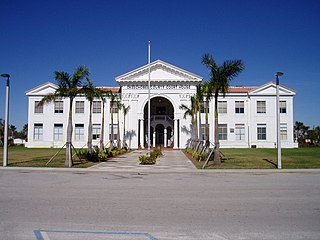
The Okeechobee County Courthouse, built in 1926, is an historic courthouse building located at 304 Northwest Second Street in Okeechobee, Florida. It was designed by architect George Gaynor Hyde of Miami in what has been variously called the Southern Colonial Revival or Mediterranean Revival style of architecture. Due to the collapse of the Florida Land Boom during its construction, its central dome was never built. After the 1928 Okeechobee hurricane, its hallways were used as a temporary morgue. An open breezeway was planned and built through the center front of the first floor but was later enclosed; the winding stairways to the second floor courtroom still remain.

The Hardee County Courthouse, built in 1927, is an historic courthouse building located at 417 West Main Street in Wauchula, Florida. It was designed by architect H.G. Little of Wauchula in the Classical Revival style of architecture. Robertson Construction Co. was the builder. In 1989, the Hardee County Courthouse was listed in A Guide to Florida's Historic Architecture, published by the University of Florida Press.

The Columbia County Courthouse, built in 1905, is an historic courthouse building located at 173 NE Hernando Avenue in Lake City, Florida. It was designed by architect Frank Pierce Milburn in the Classical Revival style of architecture. It was built with a dome and cupola, which were removed before 1989, but were restored in 2003 during a major renovation and expansion of the courthouse. In 1989, the Columbia County Courthouse was listed in A Guide to Florida's Historic Architecture, published by the University of Florida Press.

The Nassau County Courthouse, also known as the Old Nassau County Courthouse and the Historic Nassau County Courthouse, is a historic two-story red brick courthouse building located at 416 Centre Street in Fernandina Beach, Nassau County, Florida. Designed in the Classical Revival style, it was built in 1891 and features cast-iron Corinthian columns and a massive bell tower and steeple. Meneely and Co. of West Troy, New York, cast the bell for the tower, which was used as a fire alarm for many years.
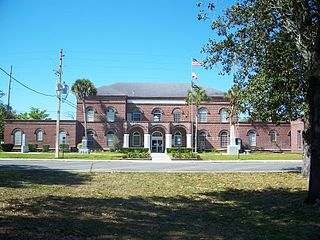
The Gilchrist County Courthouse is an historic two-story red brick courthouse building located at 112 South Main Street in Trenton, Gilchrist County, Florida. It was designed by the Jacksonville firm of Smith, Holborn, and Dozier and was built in 1933 by the Works Progress Administration. This was one of the employment programs of the President Franklin D. Roosevelt administration during the Great Depression, which invested in infrastructure of the country.
























